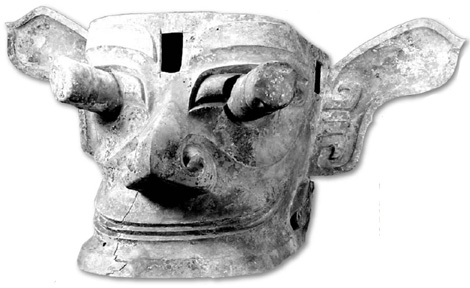Unearthing the past
 |
|
The terra cotta figurines in Western Han Emperor Jingdi's mausoleum look peaceful and amiable.[Photo: China Daily] |
Sanxingdui
In recent years, travelers heading for Sichuan province's capital Chengdu go not only to admire Wolong nature reserve's giant pandas, or Jiuzhaigou's breathtaking scenery, they also visit Sanxingdui to glimpse a mysterious ancient culture.
Less than 40 km from Chengdu, a modern and well-designed museum has been constructed over the 12-sq-km Sanxingdui ruins in Guanghan city to display cultural relics and whisk visitors back in time.
In addition to informative, easy-to-read charts and huge replicas of stunning bronze wares, the museum also preserves part of the excavation site so visitors can see how these relics were unearthed.
The excavation of Sanxingdui began in 1929, when a few farmers dredging a water channel to their fields uncovered strange bronze ware. This discovery resurrected the Sanxingdui culture, which had been interred for millennia.
Chinese and overseas archaeologists cooperated on excavations that have lasted into the 21st century. Their efforts yielded thousands of relics, including some of the country's most distinctive bronze ware with shapes unseen at any other Chinese ruins.
Three iconic bronze masks were found in the second sacrificial burial pit in 1986. They are more than 60 cm tall and nearly 140 cm wide. One of them has huge protruding eyes, grinning mouth and pointed ears that spread out like bird wings.
Researchers offered various explanations for the masks' physiognomies.
They either depict Chaicong, a legendary ancestor of the Shu people; Zhulong, a serpent with human head who controlled light on heaven and earth; or Du Yu, the fourth King of Shu, said to have transformed into a cuckoo bird who calls upon farmers to plough in early spring.
The more relics that were found, the more perplexed researchers became about the origins of the stunning culture. Originating from 5,000 to 3,700 years ago in the Chengdu Plains, the Shu Kingdom has interesting parallels to Central China's better-known Xia Dynasty (c.21st-16th c. BC).
Researchers have offered many explanations for Sanxingdui's mysteries. Some argued that the relics' outlandish shapes came from West and Central Asia. Others suggested the people of Sanxingdui were involved in an immense project inspired by an extraterrestrial civilization.
Whatever the eventual conclusion, everyone agrees that a highly developed ancient culture left clues to humankind's distant past in the secluded Sichuan Basin.
Yangling Museum
While most overseas visitors go to Xi'an, Shaanxi province, to see the Terracotta Warriors of the First Emperor of the Qin Dynasty (221-207 BC), there is a less crowded place near Xi'an that hosts equally fascinating terracotta figurines from the Western Han Dynasty (220 BC-AD 9).
Nine out of 11 Western Han emperors chose to build their mausoleums in Wulingyuan, east of Xianyang city and less than an hour's drive from Xi'an. An underground hall was completed in 2006 to display the excavation work, as part of Yangling Museum. In some areas, visitors can walk on glass suspended 2 m above the figurines, chariots and other relics.
|
|
|
An iconic bronze mask found at Sanxingdui Ruins has protruding eyes, grinning mouth and pointed ears.[Photo: China Daily] |
Since 1990, archaeologists have been working at Yangling, the mausoleum of Emperor Jingdi (188-141 BC) and Empress Wang. They've found thousands of naked and armless terracotta figurines about 60 cm tall.
Experts believe the figurines had been dressed as officials, soldiers, dancers, singers and other royal attendants. But their silky attire and wooden arms didn't stand the test of time.
These figurines appear more peaceful and amiable than the Qin's solemn, powerful and tall Terracotta Warriors.
This is likely because of their master, Emperor Jingdi. He was a wise man who believed in following Taoist doctrines to rule the country, devastated by centuries of war.
By reducing taxes and allowing the economy to rejuvenate on its own, he strengthened the empire despite constant assaults from the Xiongnu nomads from the north and civil wars waged by members of the royal family.
A tour at the museum takes visitors back some 2,200 years ago and offers clues as to why Chinese are fascinated by films and books about that period.
 0
0 









Go to Forum >>0 Comments